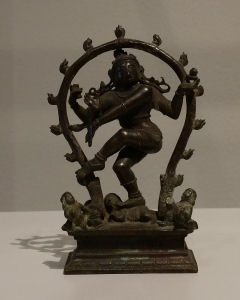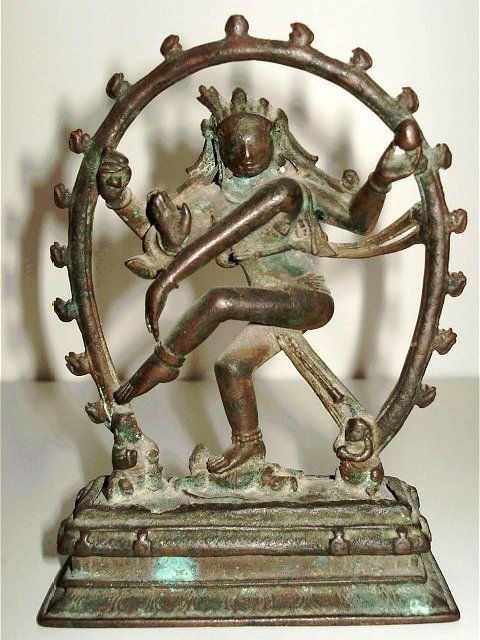SHIVA NATARAJA
South India
9th/10th Century
Bronze
Height 12 cm
SOLD
Shiva Nataraja, Chola period. Excavated, probably in the 1960s. A small but precious, finely wrought Nataraja from the greatest period in South Indian bronzes. The sculpture shows Shiva as Nataraja (Sanskrit: Lord of Dance), the source of all movement within the cosmos, represented by the arch of flames. The purpose of the dance is to release men from illusion of the idea of the "self" and of the physical world. The cosmic dance was performed in Chidambaram in South India, called the center of the universe by some Hindus. The gestures of the dance represent Shiva's five activities, creation (symbolized by the drum), protection (by the "fear not" hand gesture), destruction (by the fire), embodiment (by the foot planted on the ground), and release (by the foot held aloft). As Nataraja, Shiva represents apocalypse and creation as he dances away the illusory world of Maya transforming it into power and enlightenment.
Nataraja dances within the universe of illusion. The locks of his hair stand out in many strands as he whirls around in his dancing frenzy. His locks are a symbolic representation of the sacred river Ganges, which sprouts from his head. Shiva's unkempt hair, a symbol of a rejection of society, shows him to be an ascetic.
The upper right hand holds the drum from which creation issues forth. The lower right hand is raised in blessing, betokening preservation. The upper left hand holds a flame, which is destruction, the dissolution of form. The right leg, representing obscuring grace, stands upon Apasmarapurusha, a soul temporarily earth-bound by its own sloth, confusion and forgetfulness.
|
|

|

|
|
Shiva Nataraja sculpture in the Rijksmuseum, Amsterdam. Roughly the same size, but some 400 years younger.
|
The uplifted left leg is revealing grace, which releases the mature soul from bondage. The lower left hand gestures toward that holy foot in assurance that Siva's grace is the refuge for everyone, the way to liberation. The circle of fire represents the cosmos and especially consciousness. The all-devouring form looming above is Mahakala, "Great Time." The cobra twisting around Nataraja's upper right arm is kundalini shakti, the soul-impelling cosmic power resident within all.
Nataraja's dance is not just a symbol. It is taking place within each of us, at the atomic level, this very moment. The Agamas proclaim, "The birth of the world, its maintenance, its destruction, the soul's obscuration and liberation are the five acts of His dance." Aum Namah Shivaya.
Provenance: Private collector, Bangalore

|
 HOME
HOME

